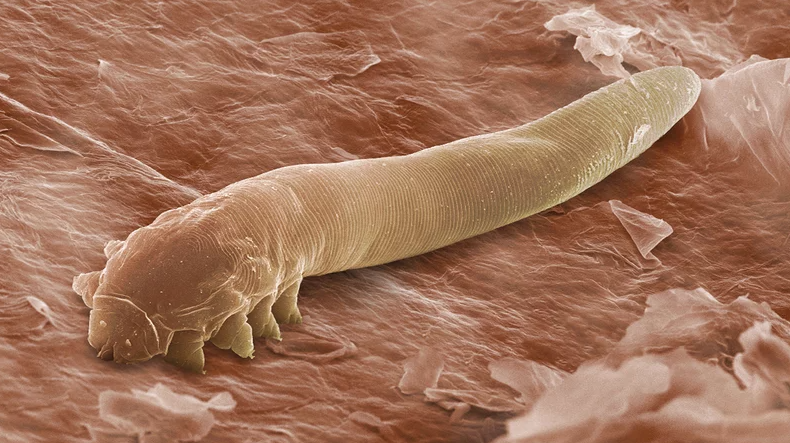The Invisible Eyelash Bugs That Can Trace Family Histories

Pictured above, via NPR, is a mite called Demodex folliculorum, or just “Demodex” for short for our purposes today. They’re thin, cigar-shaped creatures with four stubby pairs of legs near their tiny mouths, and if you think they’re gross, well, I have some bad news for you: chances are, you have some on your face right now.
But don’t worry — they’re mostly harmless. And they may even be able to help us better understand our ancestry.
Let’s first assuage any concerns you have about the creatures themselves. Demodex mites typically live in or around the hair follicles on your face, usually around your eyelashes or eyebrows. Often called “eyelash mites” as a result, they’re tiny and harmless. They measure less than half a millimeter across and can’t be seen without the aid of a microscope or similar device, so you’ll never notice them crawling around your face. They only come out at night anyway, and when they’re out, they’re actually on cleanup duty — as UCLA Health explains, “the mites are part of our body’s natural microbiome, and by cleaning up dead skin cells and excess oils, they’re actually doing us a service.” As long as their numbers stay under control, you’ll never notice their presence. If you have too many, though, you may develop a condition called blepharitis, which is marked by “red, itchy, burning eyes or eyelids, crusty eyelids or eyelashes” according to the National Eye Institute. But, as the NEI notes, blepharitis is rather easy to treat, “it isn’t contagious, and it usually doesn’t cause any lasting damage to your eyes,” so again, there’s really not a lot of reason to think about Demodex mites too much, at least not insofar as our health is concerned.
But when it comes to our ancestry? Well, maybe these eyelash mites can tell us a bit about our lineage.
Demodex mites can spread from person to person and, in fact, often do — but not all that easily. In the above-linked NPR article, the outlet spoke with Michelle Trautwein, an evolutionary biologist at the California Academy of Sciences. According to Trautwein, “you don’t share [the mites] with strangers when you give them a hug hello” — rather, they tend to spread from person to person when you’re in close, personal relationships. The eyelash mites you have on your face, therefore, are likely similar to the ones your parents, siblings, or romantic partner have had on theirs. And as a result, the mites tend to mirror our family trees.
But even if you move to a new part of the world and come into close contact with people of different lineages, your mites tend to remain attached to your old family tree. As Smithsonian reported in 2015, “Bowdoin College evolutionary geneticist Michael Palopoli and his colleagues sampled the DNA of these mites living on a diverse group of 70 human hosts. Sequencing the mites’ mitochondrial DNA revealed different lineages that closely match the ancestral geography of their human hosts. One mite lineage is common among people of European ancestry, no matter where they live in the world now, and is persistent even after generations in new locations. Other mite lineages are more common among people of Asian, African, or Latin American ancestry.” One theory, according to Science magazine, is that different subsets of Demodex mites need different skin types to thrive, and those skin types only change over dozens of generations: “Human populations differ in skin hydration, hair follicle density, and lipid production. These differences have likely arisen over evolutionary time, and the [researchers] theorize that the changes may have given certain mite clades a competitive advantage in certain skin types. Ancient Europeans, for example, may have acquired mutations in their skin that heavily favored the [one set of mites over the other].”
The research is ongoing, but one day, the microscopic janitor bugs in our eyelashes may be able to help us better understand our own ancestral histories. Even if, up close, they look kind of gross.
Bonus fact: The Mona Lisa, perhaps the world’s most famous painting, doesn’t have eyebrows — but that’s probably not how she was originally depicted. As the Telegraph reported in 2007, an engineer named Pascal Cotte used high-resolution digital scanning technology to look closely at the image, and determined that there are “traces of a left eyebrow long obscured from the naked eye by the efforts of the restorers.” Cotte’s conclusion, per the Telegraph, “is that Mona Lisa once had both eyebrows and eyelashes, but that these have been gradually eroded to the point that they are no longer visible.”
From the Archives: Why We Wake Up with Crusty Eyes: Another thing going on in our eyelashes.
